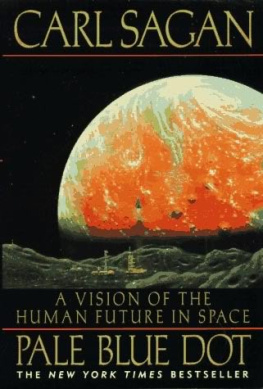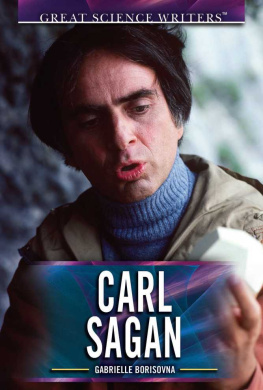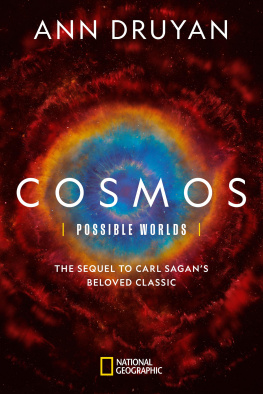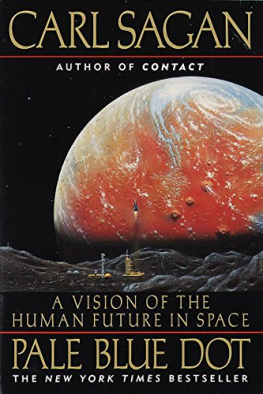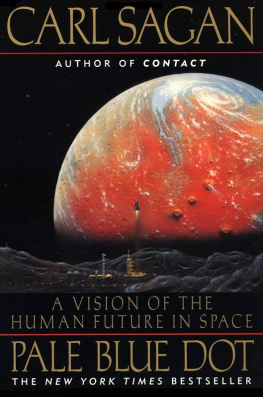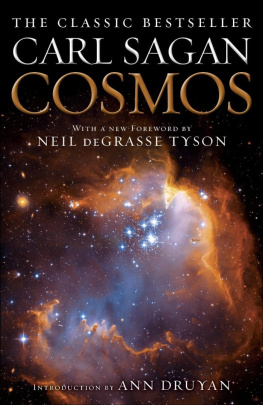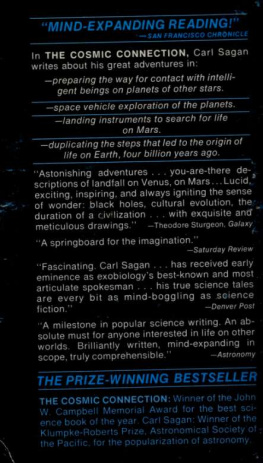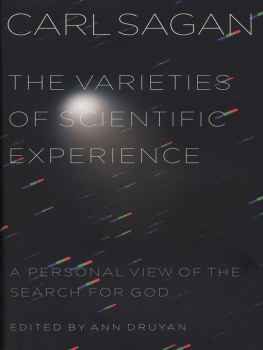Pale Blue Dot
A Vision of the Human Future in Space
by
Carl Edward Sagan
1994

All Your Books Are Belong To Us !
http://c3jemx2ube5v5zpg.onion
Pale Blue Dot
A Vision of the Human Future in Space
Copyright 1994 Carl Edward Sagan
Ballantine Books Edition, September 1997
ISBN: 0-345-37659-5
The sequel to "Cosmos: A Personal Voyage" and inspired by the "Pale Blue Dot" photograph, for which Sagan provides a sobering description. In this book, Sagan mixes philosophy about the human place in the universe with a description of the current knowledge about the Solar System. He also details a human vision for the future.
Contents
[]
"As to the fable that there are Antipodes," wrote St. Augustine in the fifth century, "that is to say, men on the opposite side of the earth, where the sun rises when it sets to us, men who walk with their feet opposite ours, that is on I'll ground credible." Even if some unknown landmass is there, and not just ocean, "there was only one pair of original ancestors, and it is inconceivable that such distant regions should have been peopled by Adam's descendants.''
[]
Copernicus' famous book was first published with an introduction by the theologian Andrew Osiander, inserted without the knowledge of the dying astronomer. Osiander's well-meaning attempt to reconcile religion and Copernican astronomy ended with these words: "[L]et no one expect anything in the way of certainty of astronomy, since astronomy can offer us nothing certain, lest, if anyone take as true that which has been constructed for other use, he go away from this discipline a bigger fool than when he came to it." Certainty could be found only in religion.
[]
St. Augustine, in The City of God, says, "As it is not yet six thousand years since the first man ... are not those to be ridiculed rather than refuted who try to persuade us of anything regarding a space of time so different from, and contrary to, the ascertained truth? ... We, being sustained by divine authority in the history of our religion, have no doubt that whatever is opposed to it is most false." He excoriates the ancient Egyptian tradition that the world is at much as a hundred thousand years old as "abominable lies." St. Thomas Aquinas, in the Summa Theologica, flatly states that "the newness of the world cannot be demonstrated from the world itself." They were so sure.
[]
Our universe is almost incompatible with life or at least what we understand as necessary for life: Even if every star in a hundred billion galaxies had an Earthlike planet, without heroic technological measures life could prosper in only about 10-37 the volume of the Universe. For clarity, let's write it out: only 0.000 000 000 000 000 000 000 000 000 000 000 000 1 of our universe is hospitable to life. Thirty-six zeroes before the one. The rest is cold, radiation-riddled black vacuum.
[]
For such ideas, words tend to fail us. A German locution for Universe is [dad 911which makes the inclusiveness quite unmistakable. We might say that our universe is but one in a "Multiverse," but I prefer to use "Cosmos" for everything and "Universe" for the only one we can know about.
[]
One of the few quasi-Copernican expressions in English is "The Universe doesn't revolve around you"-an astronomical truth intended to bring fledgling narcissists down to Earth.
[]
Since women astronauts and cosmonauts of several nations have flown in space, "manned" is just flat-out incorrect. I've attempted to find an alternative to this widely used term, coined in a more unselfconsciously sexist age. I tried "crewed" for a while, but in spoken language it lends itself to misunderstanding. "Piloted" doesn't work, because even commercial airplanes have robot pilots. "Manned and womanned" is just, but unwieldy. Perhaps the best compromise is "human," which permits us to distinguish crisply between human and robotic missions. But every now and then, 1 find "human" not quite working, and to my dismay "manned" slips back in.
[]
There could have been none. We're very lucky that there is such a world study. The others ill have too much hydrogen, or not enough, or no atmosphere at all.
[]
Not because he thought it remarkably large. but because in Greek mythology members of the generation preceding the Olympian gods Saturn, his siblings, and his cousins were called Titans.
[]
Titan's atmosphere has no detectable oxygen, so methane is not wildly out of chemical equilibrium as it is on Earth and its presence is in no way a sign of life
[]
There was one moment in the last 4,000 years when all seven of these celestial bodies were clustered tightly together. Just before dawn on March 4, 1953 B.C., the crescent Moon was at the horizon. Venus, Mercury, Mars, Saturn, and Jupiter were strung out like jewels on a necklace near the great square in the constellation Pegasus near the spot from which in our time the Perseid meteor shower emanates. Even casual watchers of the sky must have been transfixed by the event. What was it a communion of the gods? According to the astronomer David Pankenier of Lehigh University and later Kevin Pang of JPL, this event was the starting point for the planetary cycles of the ancient Chinese astronomers. There is no other time in the last 4,000 years (or in the next) when the dance of the planets around the Sun brings them so close together from the vantage point of Earth. But on May 5, 2000, all seven will be visible in the same part of the sky although some at dawn and some at dusk and about ten times more spread out than on that late winter morning in 1953 B.C. Still, it's Probably a good night for a party.
[]
After whom the European-American mission to the Saturn system is named.
[]
He so named it because of the words spoken by Miranda, the heroine of The Tempest: "O brave new world, That has such people in't." (To Which Prospero replies, "'Tis new to thee." Just so. Like all the other worlds in the Solar System, Miranda is about 4.5 billion years old.)
[]
It takes so long to circuit the Sun because its orbit is so vast, 23 billion miles around, and because the force of the Sun's gravity which keeps it from flying out into interstellar space is at that distant comparatively feeble, less than a thousandth what it is in the Earth's vicinity.
[]
Robert Goddard, the inventor of the modern liquid-fueled rocket, envisioned a time when expeditions to the stars would be outfitted on and launched from Triton. This was in a 1927 afterthought to a 1918 handwritten manuscript called "The Last Migration." Considered much too daring for publication, it was deposited in a friend's safe. The cover page bears a warning: "The[se] notes should be read thoroughly only by an optimist."
[]
The Earth, by definition, is 1 AU from its star, the Sun.
[]
Radio signals that both Voyagers detected in 1992 are thought to arise from the collision of powerful gusts of solar wind with the thin gas that lies between the stars. From the immense .power of the signal (over 10 trillion watts), the distance to the heliopause can be estimated: about 100 times the Earth's distance from the Sun. At the speed it's leaving the Solar System, Voyager 1 might pierce the heliopause and enter interstellar space around the year 2010. If its radioactive power source is still working, news of the crossing will be radioed back to the stay-at-homes on Earth. The energy released by the collision of this shock wave with the heliopause makes it the most powerful source of radio emission in the Solar System. It makes you wonder whether even stronger shocks in other planetary systems might he detectable by our radio telescope.

